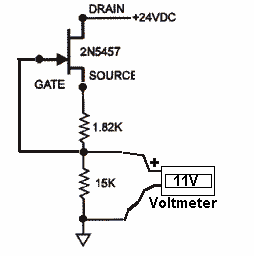[quote author="PRR"]The referenced FET sorter is for matching at a specific value of bias resistor, for use in a linear amplifier.
For variable-resistance FET use, this won't do. FETs can read the same at that one test condition and be wildly different at other conditions.
FETs vary a lot, but within one type, two measurements are all you need to interpolate the properties at all conditions.
Read the voltage with just the 100K resistor. This is (as JH says) roughly the threshold voltage, the gate-source voltage to make zero (super-low) current flow. Probably 0.5V to 8V.
Push the pushbutton to put the 10Ω resistor in. This is roughly Idss, the maximum current with gate shorted to source. About 1 to 30mA (about 10mV to 300mV in the 10Ω resistor).
So you have the two ends of the FET: current at zero bias voltage, and voltage at zero current.
Or in an FET variable resistor: you know the gate voltage where limiting will start, and the minimum resistance (maximum limiting).
We can compute the voltage and current for any inbetween condition with simple formulas. BUT if we just want a match, we can match these two points and know that all the inbetween points will track.
I suggest you start by quickly testing a lot of FETs with just the 100K (threshold voltage) test. They will be ALL over the place, 0.5V to 8V. With luck, you will find a lot all in the same ballpark. Take that lot and sort by Idss.[/quote]
Oh yes, that's clever - also measuring Idss with only closing one switch and adding a shunt for current measurment.
Which brings me back to the lowest part-count solution:
The 100k is not really needed for threshold voltage, as the internal
resitance of the voltmeter lets an ever so tiny current pass.
Now keep the very same connection (just the meter wired ito the
source), and switch it from voltage to current measurement.
So you'd even get both, threshold voltage and Idss, without
any extra components - just your DMM and a battery.
There's a catch, though: Most DMMs I've seen don't allow direct
switching from voltage to current measurement; they normally use separate input jacks for current. So your solution with switch will also be the most comfortable one in the end.
JH.




